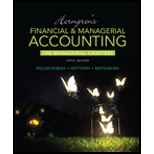
Concept explainers
The Santos Shirt Company manufactures shirts in two departments: Cutting and Sewing. The company allocates manufacturing
Compute the predetermined overhead allocation rate.
Calculate predetermined overhead allocation rate for Company S.
Explanation of Solution
Predetermined Overhead Rate: Predetermined overhead rate is a measure used to allocate the estimated manufacturing overhead cost to the products or job orders during a particular period. This is generally evaluated at the beginning of each reporting period. The evaluation takes into account the estimated manufacturing overhead cost and the estimated allocation base that includes direct labor hours, direct labor in dollars, machine hours and direct materials.
Calculate predetermined overhead allocation rate.
Therefore, predetermined overhead allocation rate is $2.50 per direct labor hour.
Want to see more full solutions like this?
Chapter 19 Solutions
Horngren's Financial & Managerial Accounting, The Managerial Chapters (6th Edition)
Additional Business Textbook Solutions
Horngren's Cost Accounting: A Managerial Emphasis (16th Edition)
Financial Accounting, Student Value Edition (5th Edition)
Principles of Operations Management: Sustainability and Supply Chain Management (10th Edition)
Gitman: Principl Manageri Finance_15 (15th Edition) (What's New in Finance)
PRIN.OF CORPORATE FINANCE
Operations Management: Processes and Supply Chains (12th Edition) (What's New in Operations Management)
- Apple Technology Corp., has an annual net income of $12.4 billion, the revenue of $93.7 billion, and a cost of goods sold of $42.5 billion. If the balance sheet amount shows $5.8 billion of inventory how many weeks of supply does Apple Technology Corp. hold?arrow_forwardSterling Equipment Ltd. purchased machinery for $80,000 with a salvage value of $5,000 and a 6-year useful life. The company initially used the straight-line method, but after two years, switched to the double-declining balance method. What is the depreciation expense for Year 3?arrow_forwardhow much is hunt's owner equity?arrow_forward
- The inventory days of supply are?arrow_forwardSuppose Chrysler Motors has 720 million shares outstanding with a share price of $68.25, and $30 billion in debt. If in three years, Chrysler has 750 million shares outstanding trading for $76 per share, how much debt will Chrysler have if it maintains a constant debt-equity ratio?arrow_forwardi want to correct answer is accountingarrow_forward
 Principles of Cost AccountingAccountingISBN:9781305087408Author:Edward J. Vanderbeck, Maria R. MitchellPublisher:Cengage Learning
Principles of Cost AccountingAccountingISBN:9781305087408Author:Edward J. Vanderbeck, Maria R. MitchellPublisher:Cengage Learning Managerial AccountingAccountingISBN:9781337912020Author:Carl Warren, Ph.d. Cma William B. TaylerPublisher:South-Western College PubPrinciples of Accounting Volume 2AccountingISBN:9781947172609Author:OpenStaxPublisher:OpenStax College
Managerial AccountingAccountingISBN:9781337912020Author:Carl Warren, Ph.d. Cma William B. TaylerPublisher:South-Western College PubPrinciples of Accounting Volume 2AccountingISBN:9781947172609Author:OpenStaxPublisher:OpenStax College Cornerstones of Cost Management (Cornerstones Ser...AccountingISBN:9781305970663Author:Don R. Hansen, Maryanne M. MowenPublisher:Cengage Learning
Cornerstones of Cost Management (Cornerstones Ser...AccountingISBN:9781305970663Author:Don R. Hansen, Maryanne M. MowenPublisher:Cengage Learning Financial And Managerial AccountingAccountingISBN:9781337902663Author:WARREN, Carl S.Publisher:Cengage Learning,
Financial And Managerial AccountingAccountingISBN:9781337902663Author:WARREN, Carl S.Publisher:Cengage Learning, College Accounting, Chapters 1-27AccountingISBN:9781337794756Author:HEINTZ, James A.Publisher:Cengage Learning,
College Accounting, Chapters 1-27AccountingISBN:9781337794756Author:HEINTZ, James A.Publisher:Cengage Learning,





